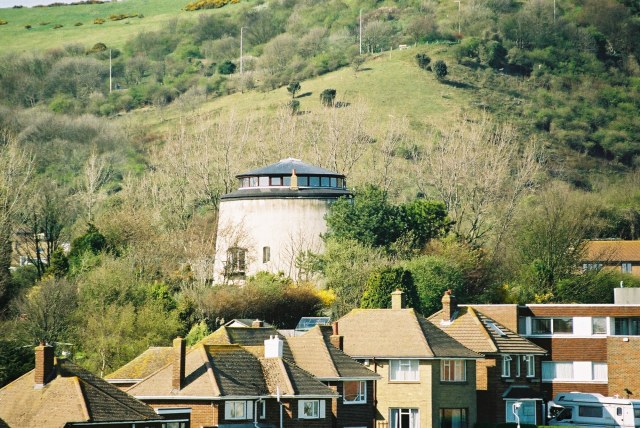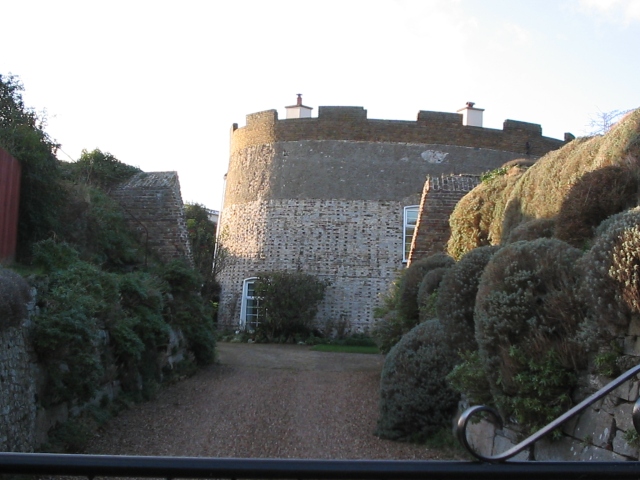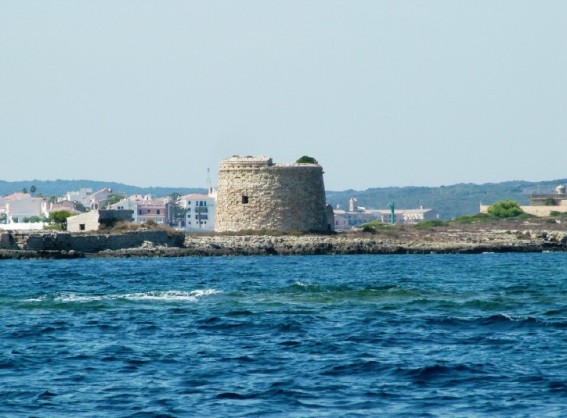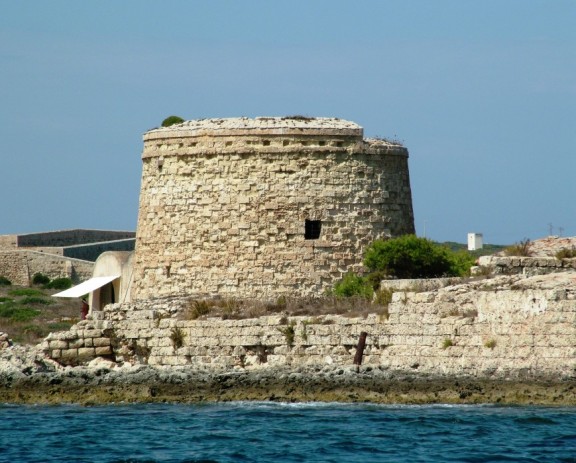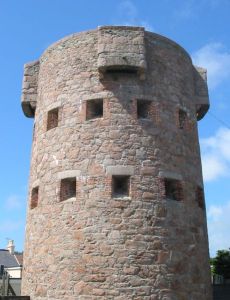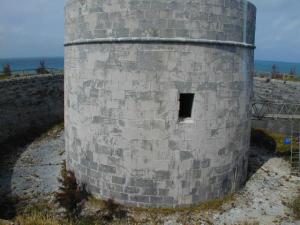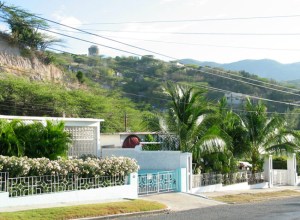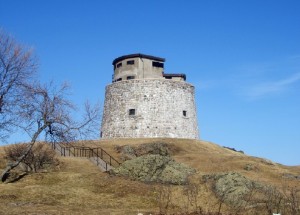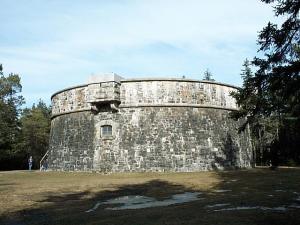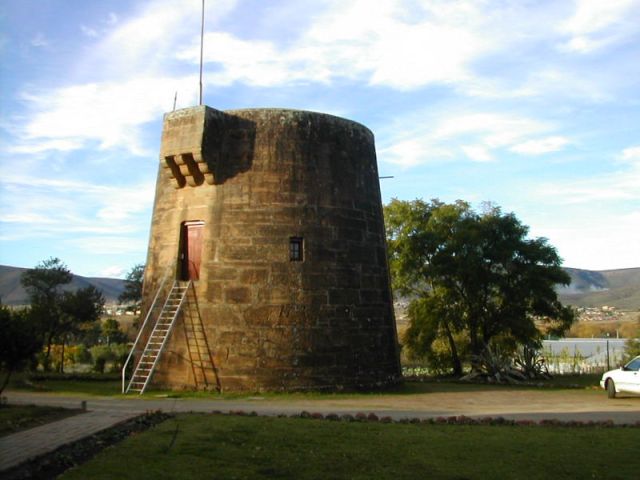Martello Towers in England and other Countries.
Martello Towers in England
As would be expected, the heaviest concentration of Martello towers were built on the south east and south coasts of England considered to be vulnerable to invasion during the Napoleonic wars. A total of one hundred and three towers were built between 1805 and 1812, 31 were located between Point Clear in Essex and ending in Aldburgh in Suffolk and seventy towers twere built along the South Coast between Folkestone and the beach at Seaford in Suffolk. Although primarily intended to protect from invasion, many of the towers were strategically positioned to defend existing gun batteries and important canal routes leading to the sea.
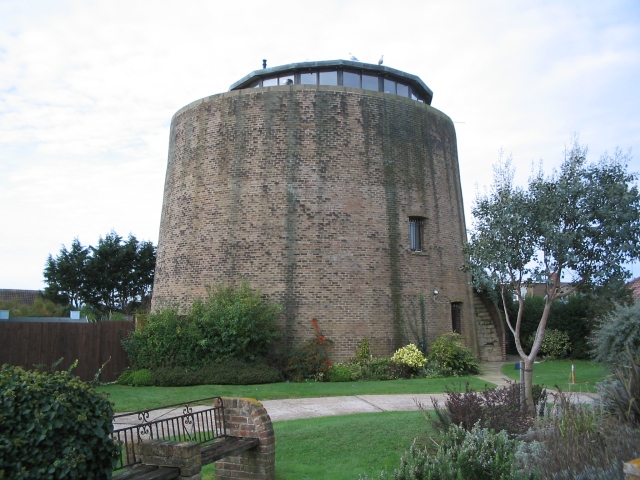 Pevensey Bay Village Martello Tower, courtesy Steve Popple,Folkestone is one of seven towers built at Eastbourne,all are still standing but several towers are under threat of coastal erosion.
Pevensey Bay Village Martello Tower, courtesy Steve Popple,Folkestone is one of seven towers built at Eastbourne,all are still standing but several towers are under threat of coastal erosion.
Felixstowe is the largest container port in the U.K and one of the largest in the World.
On November 4th.2006 the port was visited by the “Emma Maarsk” the largest container ship in the World. Felixstowe was also targeted during the second World War and was bombed by Mussolini’s airforce before being forced to retreat by the superior RAF that shot down many of their planes over Felixstowe .
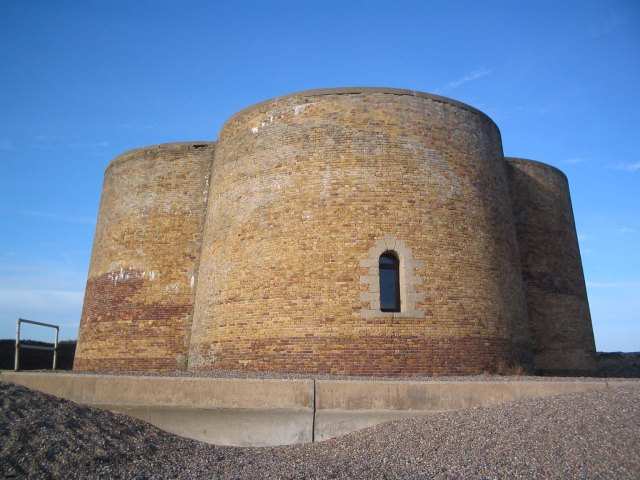 Aldeburgh Tower, Suffolk where Sheila Sutcliff played as a child and later in 1976 as an Author published the first known book on Martello towers and now a valuable source of reference. Photograph courtesy Steve Popple, Folkestone, Kent ©
Aldeburgh Tower, Suffolk where Sheila Sutcliff played as a child and later in 1976 as an Author published the first known book on Martello towers and now a valuable source of reference. Photograph courtesy Steve Popple, Folkestone, Kent ©
An index of all the English towers is not intended for this presentation and it is recommended that those interested in the locations and photographs of all the English Towers, on the South Coast and East Coasts of England, design history and current status of the Towers should check the many websites covering the towers in England.
The photographs here are courtesy of Steve Popple, Folkestone, Kent who has over the years built up his own large collection of the English Martello towers and kindly sent them to me on hearing of my interest during his visit to Dublin 2006 when he visited the Martello tower at Howth.(Author). Large numbers of Martello towers were also built in Canada and Jersey and Guernsey and appropriate links to sources are also listed.
Similar to the placement of many towers in Ireland, many of the English towers were positioned to cover each other and to create cross-fire barriers to attackers. Only forty nine of the towers remain standing today, many of which are in ruins or have been converted as private residences. Nine of the towers are in their original condition. Dymchurch Martello Tower in Kent has been impressively restored and is now a Museum (SEE CREDITS PAGE )
See MARTELLO TOWERS IN ENGLAND websites
http://www.ecastles.co.uk/martello.html and more
MARTELLO TOWERS BUILT IN OTHER COUNTRIES
| Minorcan Towers (Minorca and Majorca) |
Minorcan towers played a part in the evolution of the design of the Martello tower adopted by the British and constructed in England and had some modifications for Ireland as also did the towers erected at Halifax, Nova Scotia and at Key West in Florida, Guernsey and Jersey Islands. The prominence of a Martello tower in Corsica in 1794 was not the first time that a defensive tower was in place to defend against invaders but it did appear to have the advantage of many years of development of various designs and it was new defensive features that made the Martello towers unique. These were the conical shape, rising from the base that had the effect of deflecting cannon balls from an aggressor, an entrance door, accessed by rope or ladder on the landward side and usually flanked with windows, the line of fire being downward to engage attacking land forces. Towers were designed so that that wall thickness was far thicker on the seaward side (three metres) and narrower on the landward side (2 metres) to withstand attack and the provision of a furnace to heat shot that proved lethal in those days of wooden ships and canvas sails. Machinations were also a prominent feature of most of the towers in Ireland with musket ports to repel any attempt to enter the tower, commonly called “murder holes”.
Martello Towers near the Port of Mao, Minorca.© Photo Tony Walsh, Dublin.
http://www.mallorca-torres.de/index_uk.php?site=torres_index_menorca
General Information
On the island of Minorca has to distinguish between two generations of towers. It is from the Spanish period 1500 – 1700 and British in the period from 1700 – 1800. The British also use the built towers by the Spaniards. Architecturally, the towers are different but barely. The 14 towers built in 1785-1805 is also called “Martello Towers”. As the “Martello Tower” in the Cape Martello in Corsica. The “Martello Tower” is therefore regarded as a prototype. In Minorca, the British built 11 and the Spaniard three of these towers. In the index, I have marked the “Martello Towers” for better clarity. As in most cases they consist of stone “Mares”. They have two floors and provided with a platform. It consisted of sight from tower to tower. By day, was triggered by smoke signals and signs at night by fire alarm.
After the disastrous raid pirate Barbarossa (Khair ed-Din) in 1535 in Mahon, the “Castell de Sant Felip” was one of the largest fortresses in Europe, was built. Since Mahon was impregnable to the pirates now sailed the next pirate, pirates led by Mustafa Piali in 1558 continue to Ciutadella and destroyed it. There were many residents in the attacks of both cities enslaved or killed. After the last serious attack in 1558, the island of King Philip II to be depopulated. The raids were also Turkish and Algerian pirates until about 1830
Here you will find all Torres in alphabetical order and their exploration Date: SEE SITE URL ABOVE.
Scotland: Leith and Orkney Islands
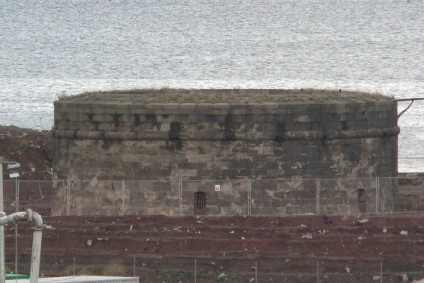
Leith Martello Tower, known as the “Telly Tower” was built in the open sea off Leith Sands at the mouth of Leith harbour. Carvings of Irish Celtic folk symbols on the stonework would suggest that migrant labourers worked on the construction of the tower. In 1936 work commenced on the building of a breakwater around Leith harbour and it is now part of the dockland area with possibilities that the tower will someday be restored.
The Martello towers constructed on the Orkney Islands between 1813 and 1815 were built
for the purpose of protecting the merchant ships as they assembled in the sheltered deep water Bay of Longhope awaiting ships of the Royal Navy to escort them on their journey around the north of Scotland and the Orkney Islands to Scandinavian and Baltic ports. Two towers were constructed, one south east of the battery at Hackness (Hoy Tower) and the other at the opposite side of the entrance to Longhope Sound at Crockness. In 1812 the United States of America declared war on Britain and the US Navy ships and privateers were active in the North Atlantic harassing shipping.
Hackness Martello Tower Hoy Orkney Islands
Hackness Martello Tower, known as Hoy Tower is part of a large defensive network at the entrance to Longhope Sound and opposite another Martello tower at Crockness, See Figure 104} strategically placed similar to other towers, to provide cross-fire at unwanted enemy intrusions . Constructed on the Island between 1813 and 1815 the Hackness tower was positioned beside a large gun battery and Barracks and has been carefully restored as it would have been circa 1866 and on the side facing the sea the walls are 4.25m thick and is one of the few towers where the complete gun assembly (with gun) can be seen functioning as was originally intended.
Photos http://www.undiscoveredscotland.co.uk and further information.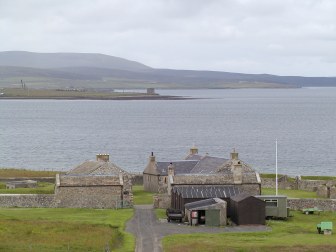
Crockness Martello Tower ,view from Hackness Battery, Longhope Strand.Scotland
To fully appreciate the extent of the restoration that has taken place, those who are unable to visit the Museum can view the restored interior and gun assembly at the website http://www.undiscoveredscotland.co.uk . Search for Hackness Martello Tower to open the Hackness Museum website and obtain the history of the Tower with many images.
Bookmark this site as you may wish want to re-visit or to look up travel information and tourist facilities.
Jersey Island Towers.
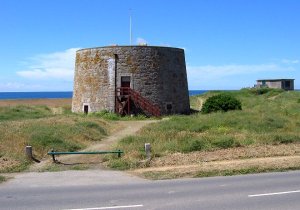
Kemp Tower Jersey, view from the road. Photos courtesy Andy Jay. Jersey
At the beginning of the thirteenth century the Channel Islands were a part of the Duchy of Normandy until Normandy was lost to France by King John but Jersey chose to remain loyal to the British Crown. On eight occasions over the following centuries attempts were made by France to invade the Island and the threat of invasion was always a constant concern of the islanders that the Island would eventually be taken. In more recent times, several attempts were made, the most successful being in 1781 when Baron de Rullecourt and 600 troops landed at La Rocque . The invasion force met no resistance until they reached the Capital St. Helier and forced the Lieutenant-Governor Major Corbett to sign a document of surrender. The surrender order was not accepted by large garrisons at Elizabeth Castle (guarding St.Helier Harbour) and St.Peter’s Barracks and assembled the Jersey Militia , attacked and defeated the France that were mustered at St.Helier.
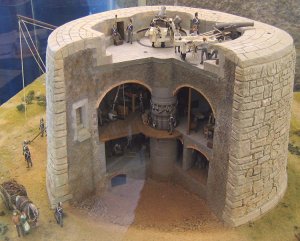
Model of Kemp Tower Jersey on display in museum.
Major Pierson who was in command of the St.Peters Barracks and De Rullecourt were killed in the historic Battle of Jersey. Pierson became a local hero and was buried with full military honours in St.Helier’s Church. The next foreign force to invade Jersey was the German Army who occupied the Island from 1940 to 1945 during the Second World
War.
The Conway Towers
The network of Towers around the coasts of the Island are referred to as The Conway Towers. Photo courtesy Man vyi
In 1776 the Governors of Jersey had just cause to be very concerned when France began to send money to help the Americans in their War of Independence and it was rumoured that the French had 14,000 ready to invade with long term plans to deport the population and replace them with French citizens. The decision was taken to encircle Jersey with a network of watchtowers to warn of any invasion threat by the French. One of the Governors, General Conway drew up a plan to erect 32 Towers that were designed by a French nobleman and some of the towers were to have the addition of a battery at the base of the tower. Work on erecting the Towers commenced in 1778 and when Conway died in 1795, twenty two of the planned thirty two Towers had been constructed.
By this time the success of the tower at Cape Mortella in Corsica was broadly known and a design change in the Conway towers was made based on the tower at Mortella and the last remaining eight towers to be built were similar to those built in England.
Martello towers based on the “Mortella” design were constructed in Jersey 16 years before being adopted by the British for the defence of the south coast of England.
In total thirty one towers were built, of which twenty four remain.
Guernsey Island
The Towers in Guernsey were also ordered to be built by General Conway, Governor of Jersey and Military commander in the Channel Islands. Guernsey’s fifteen towers were built in less than a year and similar in design to the towers built along the South East Coast of England between 1805 and 1812. Conway, knowing the developments that were taking place in artillery power and the threat of enemy landings from small craft ordered the construction of the towers as a matter of urgency
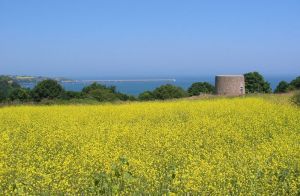
Victoria Tower, St.Catherine’s Breakwater, Jersey. Photo courtesy Man vyi
BERMUDA
Bermuda
There is a Martello tower located at Ferry Reach, St.George’s Parish. It was completed in 1812. Built with hard Bermuda stone it is the only Martello tower constructed even thought there were ninety forts constructed by the British on the Island. Many of these structures are in good condition and have been restored as historic sites by the Government of Bermuda. This tower was modelled on the Barbuda tower and used as a gunpowder store for the Magazine nearby. There are also large forts at Ferry Reach, Ferry Island and Burnt Point and a full listing of the remaining restored Forts and images can be seen at Bermuda.com website.
Jamaica
At least 24 Forts are established in Jamaica and all were further fortified during the Napoleonic wars. One of these forts at Harbour View was built by the Spanish Slave Agent in Jamaica, James Castillo, to guard his home against attack. This fort was later strengthened by the English Governor George Nugent by the addition of a Martello tower and named after him to guard the eastern entrance to the city of Kingston. In 1806 a Martello tower was added and the tower is all that remains now.
Canada
Carleton Martello Tower, St.John, New Brunswick(above)
A total of sixteen towers were built in Canada and eleven are still standing. Canadian Towers were built with removable cone-shaped roofs to protect against the snow and were easily dismantled when required to expose the cannons. Towers that have been restored now have permanent roof additions.
The first tower to be built was in 1796 and located in Point Pleasant Park in Halifax, Nova Scotia. This was one of 6 towers built to protect Halifax and is now restored as a National Heritage site.
The City of Quebec was another location selected for the positioning of four Martello towers and the largest concentration of six towers were at Kingston, Ontario to defend its harbours and naval shipyards.
Two of the Kingston Towers, Murney Tower and Fort Frederick are museums and attract many visitors during the summer months. Another Tower at Saint John, New Brunswick, the Carleton Martello Tower (seen below)) has also been restored and attracts many visitors. Visitors can view an audio-visual presentation and view the restored Powder Magazine and Barracks and many exhibits relating to the tower.
Halifax, Nova Scotia(above)
The oldest Martello tower in Canada is the Prince of Wales Tower, built in 1796 and located in Point Pleasant Park, Halifax., Nova Scotia. Similar to many towers in England and Ireland, the strategic placement of this tower was the result of careful assessment of the vulnerability of the existing Halifax Harbour defences in the event of attack from the French West Indies Fleet. The armaments of the tower were four 6-pounder carriage guns, two 24-pounder guns on traversing platforms and six 24-pounder carronades on traversing sides on top. The facing material on the two-story tower is ironstone rubble masonery.with 8-foot thick walls. The tower is twenty six feet high and seventy two feet in diameter,
http://www.pc.gc.ca/eng/lhn-nhs/nb/carleton/natcul/natcul3.aspx
Site page preview :
Carleton Martello Tower National Historic Site of Canada
Martello Towers
A Solid Presence
Carleton Martello Tower is just one of over 200 defence towers that the British built worldwide. Between 1810 and 1847, eleven Martello towers were constructed in British North America. In an age of smoothbore artillery, these towers were seen as an effective and affordable way to protect coastal areas from enemy attack.
But what makes a tower a Martello tower? Martello towers, whether in Canada, England, or Mauritius, all had certain features in common. For instance, these structures were circular in shape with a flat roof on which artillery could be mounted. The towers were accessible through a doorway in the second storey, or barrack floor. The ground floor had storage space and a gunpowder magazine. The key feature was a round, brick pillar that supported both the roof and the arched brick ceiling which, along with the thick walls, was designed to absorb artillery fire. Based on these elements, it is easy to see why Martello towers gained a reputation for strength.
Australia
Sydney Harbour
One of the last Martello towers to be built in the world was in Sydney Harbour (on Pinch Gut Island, a small reef) to defend Sydney against Russian Warships was named after Sir William Denison, then Governor of New South Wales. This tower is in good condition and except for some damage caused when in May 1942 a Japanese midget submarine entered the harbour having succeeded in passing through the submarine nets but was detected and fired upon by the American cruiser USS Chicago. A secondary salvo hit the Martello tower, causing still visible damage. In 1994 the island became part of the Sydney Harbour National Park. It has a modern museum and café and attracts nearly 16,000 visitors annually.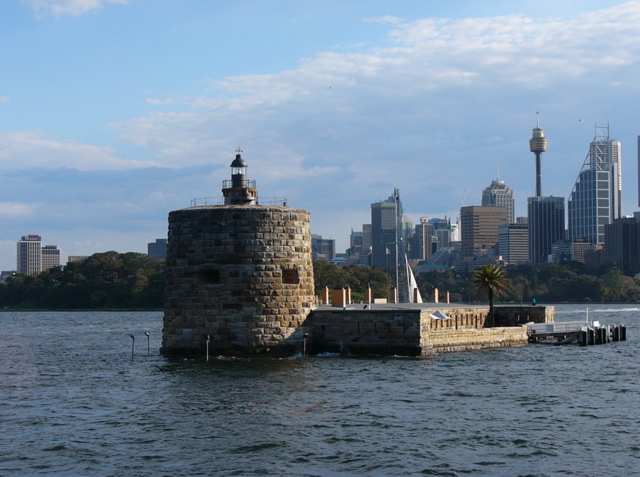
Fort Dennison. Sydney Harbour .Photo GNU FDL
UNITED STATES OF AMERICA MARTELLO TOWERS
Walbach Tower, New Hampshire During the British blockade of 1814 a brick casemated Martello-type tower known as Walbach Tower was constructed on a small hill west of Fort Constitution and named for and after Colonel John de Barth Walbach, originally from Germany, who served in the French Imperial Army until joining the American Army in 1799 as a lieutenant of light dragoons, and was now second-in-command of all New England seacoast defences.
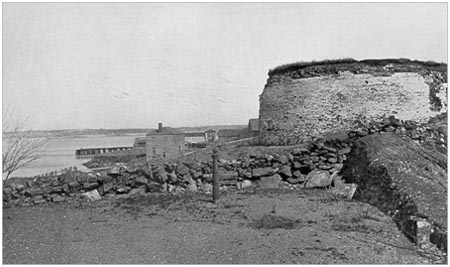 Walbach Tower,New Castle, Portsmouth, New Hampshire (Photo Portsmouth Public Library)
Walbach Tower,New Castle, Portsmouth, New Hampshire (Photo Portsmouth Public Library)
The tower mounted a 32-pounder naval gun on its roof to fire on ships in the channel to the east and south, as well as three small field guns in casements to protect the landward approach from the west only the remains of the foundation and magazine remain to-day.
Fort Johnson, Charleston, South Carolina
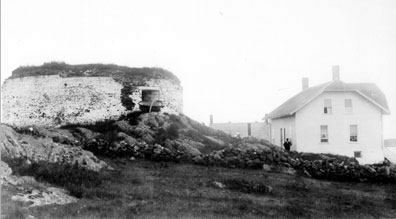 Walbach Tower before being reduced to rubble by hurricane Katrina when the storms reached Charleston late August 2005.
Walbach Tower before being reduced to rubble by hurricane Katrina when the storms reached Charleston late August 2005.
Fort Johnson was built in 1704 to meet the threatened invasion by the French fleet and reconstructed in 1759 when it became a British Military Post. Further seizures of the Fort by the Colonials and violent storms that breached the sea walls left the Fort in ruins by the year 1800. Later in 1827 a Martello tower was constructed nearby and other permanent buildings for officers and men. In 1861 to aid in the destruction of Fort Sumter the South Carolina State troops erected two 10-inch mortar batteries of two mortars each and an earthwork of three guns, and at four o’clock on the morning of April 12th.1861 a single shell was exploded over Fort Sumter and this was the signal for the bombardment of Sumter to begin and marked the beginning of the American Civil War. No traces remain of the original Fort Johnson which stood at Windmill Point on James Island.
Fort Johnson is probably best remembered today as the place from which one signaling mortar shell was fired — a shell that opened the bombardment of Fort Sumter. The ultimate appeal had been made in the hitherto political conflict between North and South, for that one mortar shell symbolized the appeal to take up arms.
Lake Borgne Louisiana, USA
This tower built on the shores of Lake Borgne, Savannah to protect New Orleans from attack by the narrow channel leading to the old city. Having being exposed to many climate changes and severe weather conditions for almost 200 years the tower was to be finally demolished by Hurricane Katrina in August 2005 and all that remains now is a heap of rubble . An early Mugnier distant photograph of the tower taken circa end of the nineteenth century clearly shows the tower on a marshy headland with access and it is a credit to Louisiana photographer Matthew White to have taken, what is regarded as the last close-up photograph of the tower, known locally, as the Martello Castle.
 The Martello Tower, known as Martello Castle on the shores of Lake Borgne, Louisiana is reproduced by kind permission of Matthew White, Photographer, Slidell LA and is probably the last known close-up photograph of the Tower to be taken before Hurricane Katrina devastated New Orleans and surrounding areas in Louisiana on August 25th. 2005 and demolished the tower. Matthew White returned to the tower in the aftermath of the hurricane only to find a heap of rubble and this image can be seen on his Website section Aftermath of Katrina http://rigolets.blogspot.com/
The Martello Tower, known as Martello Castle on the shores of Lake Borgne, Louisiana is reproduced by kind permission of Matthew White, Photographer, Slidell LA and is probably the last known close-up photograph of the Tower to be taken before Hurricane Katrina devastated New Orleans and surrounding areas in Louisiana on August 25th. 2005 and demolished the tower. Matthew White returned to the tower in the aftermath of the hurricane only to find a heap of rubble and this image can be seen on his Website section Aftermath of Katrina http://rigolets.blogspot.com/
Tybee Island State of Georgia
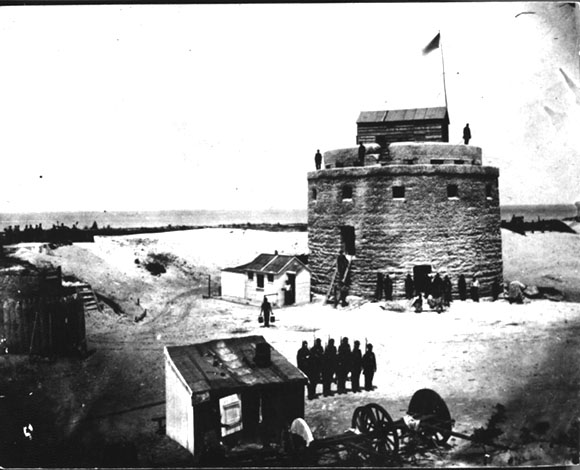 Tybee Island Martello type Tower occupied by Union forces during the American Civil War. Designed to protect the entrance to the Savannah River. (Source Tybee Island Lighthouse Museum. Public domain image))
Tybee Island Martello type Tower occupied by Union forces during the American Civil War. Designed to protect the entrance to the Savannah River. (Source Tybee Island Lighthouse Museum. Public domain image))
Located at the north end of Tybee Island, in the State of Georgia, the Martello tower was built by the United States Government in the early 1820’s. It was one of 6 towers constructed along the Atlantic coast as part of a coastal defence system. This tower was in the encampment of Fort Screven later to be destroyed by the American Government and only archaeological remains of the Martello towers can still be seen.
Tybee Island played a significant role in the defeat of the Confederates in the American Civil War. They held the massive Fort Pulaski less that a mile away from Tybee Island and was eventually surrendered when the Union forces constructed several batteries at Tybee that fired new artillery weapons called “rifled cannon” to penetrate its walls and this victory led to many similar Forts being abandoned, including Martello towers as they could no longer guarantee protection against this new weaponry.
Key West, Florida
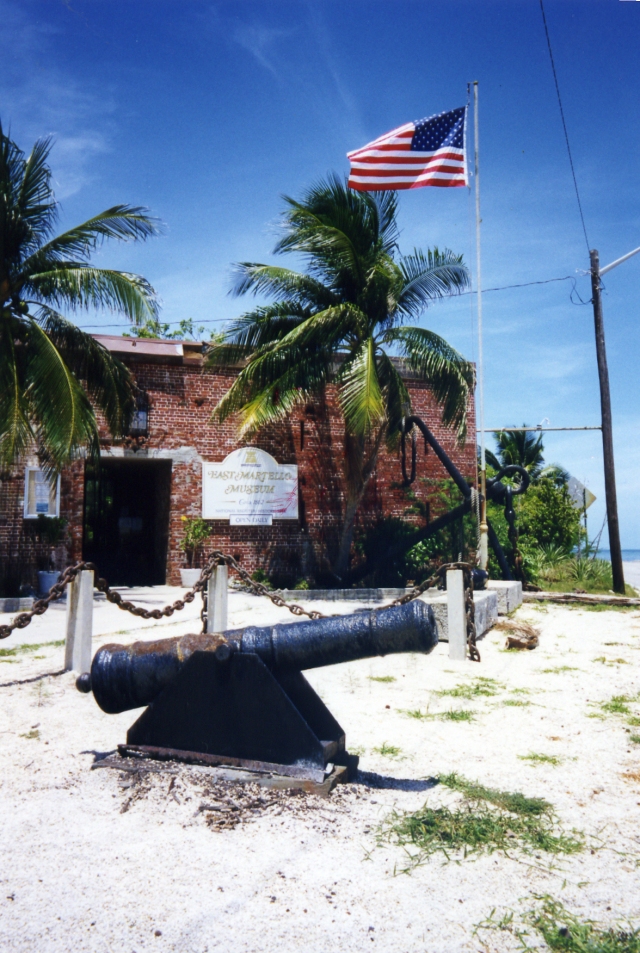 Courtesy Key West Art and Historical Society, Florida
Courtesy Key West Art and Historical Society, Florida
On the outbreak of the American Civil War, two Martello towers were built to further strengthen the Island’s defences. Tower No.1 on the westward side was called Fort Taylor and Tower No.2 was built on the eastward side, this work commenced in 1862. During the construction of this tower, excavations uncovered the site of a former African Cemetery where slaves were buried and their remains were reburied elsewhere and the work on the tower was discontinued and the uncompleted tower abandoned.
In 1898, during the war with Spain, the tower was again reinforced by the Army on the seaward side of the Fort and during World War 11; an anti-aircraft battery was also mounted there, with troops stationed in barracks nearby. The tower was used for military training and was decked out with radio receiving aerials.
Mauritius.
La Preneuse Martello Tower Museum. Riviere Noire.When the British captured Ile de France from the French in 1810 and renamed it Mauritius there were over 40 coastal batteries and fortifications on the Island. The British were adamant to maintain control of the Island, especially the Ports that were an important stopping over for shipping to the Far East during the 17th. 18th,and 19th centuries. The ease with which the British overran the French occupiers convinced the new rulers of the importance of reinforcing existing fortifications. A threat of attack existed from Madagascar as well as the danger of civil uprising by the French settlers. During British rule, large forts were constructed at Fort George, Fort Adelaide, Fort William and Fort Victoria. Five Martello towers were built between 1832 and 1835 at Grand River North West, Black River and Port Louis.
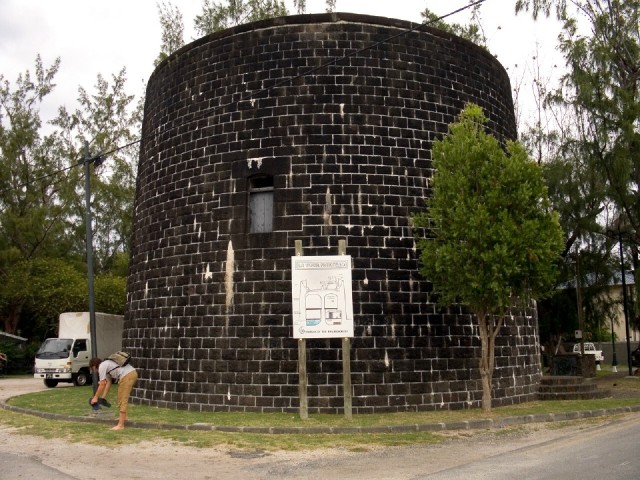 La Preneuse Martello Tower, in Riviere Noire, Black Valley, Mauritius
La Preneuse Martello Tower, in Riviere Noire, Black Valley, Mauritius
Restored by the Friends of the Environment. Last remaining Tower of 5 built is a symbol of the end of slavery in Mauritius. This Tower is ranked as one of the finest preserved towers in the World. Image © and reproduced by kind permission of the National Heritage Fund, Three towers, Cunningham Tower, Tower Fort Victoria and another at Riviere Noire no longer exist. The L’Harmonie Tower at Les Salines in due for restoration and return to its original condition.
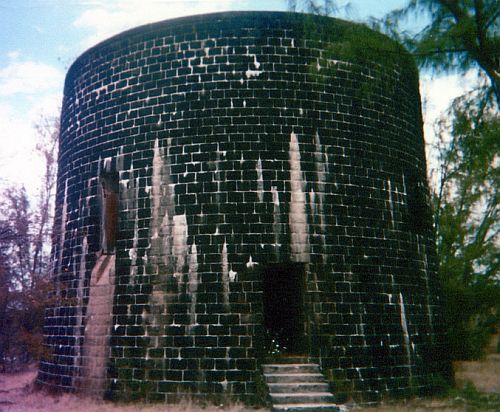 L’Harmonie Martello Tower, Les Salines Mauritius. By rubared Wikipedia FDL GNU licence)
L’Harmonie Martello Tower, Les Salines Mauritius. By rubared Wikipedia FDL GNU licence)
Antigua and Barbuda
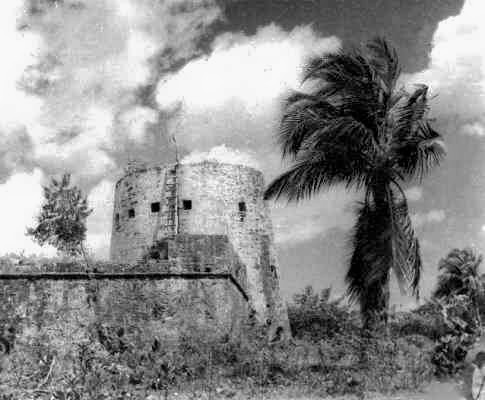 Located on the south coast of Barbuda, this tower was primarily used as a watch tower to obtain advanced notice of incoming ships or wrecked ships.
Located on the south coast of Barbuda, this tower was primarily used as a watch tower to obtain advanced notice of incoming ships or wrecked ships.
The information was then signalled onward to the village of Codrington to the north. This tower was armed with ten cannon and stood 56 feet high and equipped to guard over nearby River Landing, which was Barbuda’s original Quay.
Simonstown, South Africa ( Cape of Good Hope)
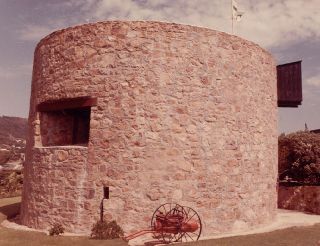 The restored Martello Tower in Simon’s Town, South Africa
The restored Martello Tower in Simon’s Town, South Africa
by kind permission os Simon’s Town Museum and Heritage Society
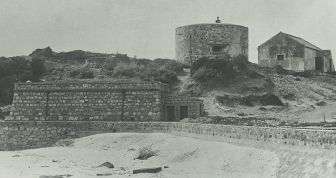 Photographs by kind permission of Simon’s Town Museum and Heritage Society
Photographs by kind permission of Simon’s Town Museum and Heritage Society
The Martello tower, powder magazine and gun Battery was built in 1868. Three of the four 32-pounder guns mounted “en barbette” can be seen on either side of the tower with the three 18-pounder in a row on the left. The 9-pounder can be seen over the extreme left of the Magazine building. Soon after the outbreak of the First World War the Royal Marines were withdrawn and replaced by the South African BNVR sailors.
Fort Beaufort Cape Town Eastern Cape SA
.Fort Beaufort Martello Tower Cape Town Photo F.FJacot-Guillarmod GNU free licence.
An excellent example of a preserved Martello tower at Fort Beaufort completed in 1857.
This Tower has a central emplacement for rotating cannon on roof, basement magazine and store room and first floor barrack room. In the fifth frontier war between the Xhosa and the white settlers, the Xhosa were driven back across the Keiskamma River. Fort Beaufort was built by the Cape Government to maintain peace and create a buffer zone between the two factions. Later during the eight frontier war it withstood an offensive by a full Xhosa army. Located between the banks of the Keiskamma and Great Fish Rivers it was an ideal defensible position for this purpotower on the west end of Tortula below Fort Recovery is early example of the Martello Tower built in England. Photo by LEGIS GNU FDLse.
British Virgin Islands: Fort Recovery, Tortola
 The tower on the west end of Tortula below Fort Recovery is early example of the Martello Tower built in England. Photo by LEGIS GNU FDL
The tower on the west end of Tortula below Fort Recovery is early example of the Martello Tower built in England. Photo by LEGIS GNU FDL
Fort Charlotte on the West End of Tortola in the British Virgin Islands was built by the British Royal Engineers in 1794 at an elevation of approximitely 947 feet over Road Town. However,it was constructed on top of an earlier wooden stockade believed to have been originally erected by the privateer Joost Van Dyk to act as a lookout post . The fort was named after Charlotte of Mecklenburg-Strelitz, who was the wife of King George 111 Due to the high position of the fort, a martello tower, Fort Recovery, was constructed at sea level to ward off attackers with cannon fire. This tower is an example of the martello towers built by the British during the Napoleonic Wars. At the time of hostilities between the Dutch and the Spanish the site was originally an earthen fort and used as a barracks for wounded and sick soldiers, and obtained the name Fort Recovery. When the British seized the Islands in 1672 the fort became a ruin for over half a century and it was on this site the built this fort along with the rebuilding of other old forts that formed a triangular defensive formation around Road Harbour. On the south west side of the harbour was Fort Burt. On the northwest was Fort George. In the middle lay Road Town Fort and towering above both was Fort Charlotte, with the range and guns to fire on any ship entering the harbour without any fear of return fire.
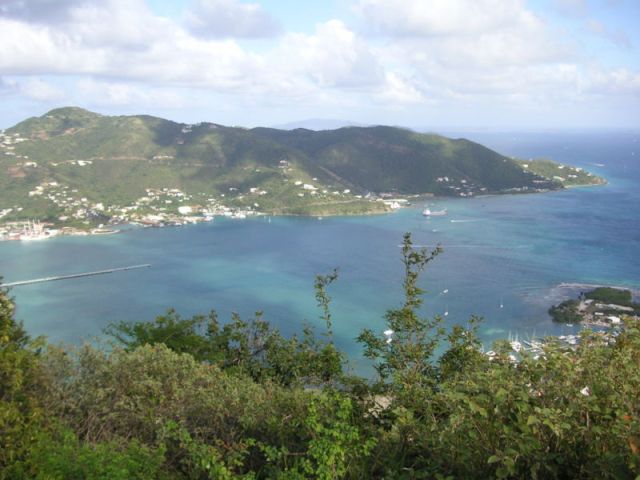 View of Road Harbour from the ruins of Fort Charlotte, Tortola by Legis GNU FDL
View of Road Harbour from the ruins of Fort Charlotte, Tortola by Legis GNU FDL
As the photograph shows, Fort Charlotte held a commanding position overlooking the harbour and the Martello tower was built to compensate for the lack of elevation of the cannon at the Fort. Once again the tower was abandoned in the early 1800s when the Colonial wars ceased. Another reason forwarded was that the fort was built to protect the source of freshwater, a freshwater pond and when the pond dried up there was no further purpose in maintaining the fort. The formidable defences at Tortola and low economic value of the territory was sufficient to deter would be invaders. When the colonial wars ended the forts were vacated and allowed to fall into ruin.
Part of the remains of the walls of Fort Charlotte can still be seen but access is extremely difficult due to extensive bush overgrowth. Fort Burt was rebuilt and converted into the island’s first hotel in 1953, Fort Recovery is also a hotel. The Bougainvillea clinic was built on the foundations of the Road Town Fort and Fort George is also in ruins and no public access.
Indonesia:
Menara Martello Tower, Bidadari Island.
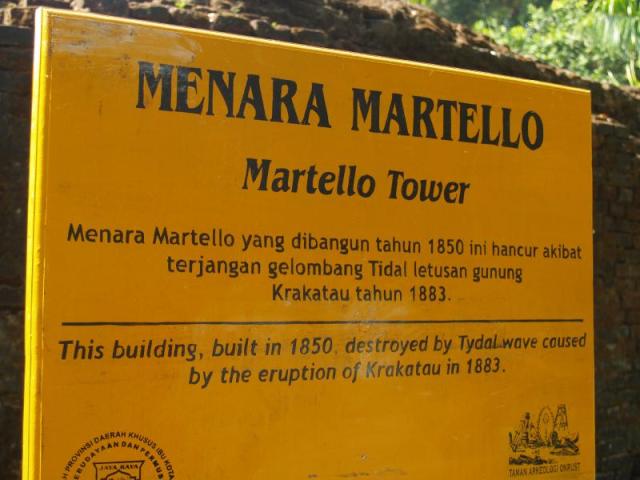
Menara Tower Built in 1850 and destroyed by tidal wave caused by eruption of Krakatau 1883 Sign erect by Taman Arkeologi Onrust.
Located in thousand island Bidadari is very much part of Jakarta history. Bidadari is one of the most popular of the thousand island as a tourist attraction and can be reached by fast boat from Marina Ancol. The pure natural beauty of the island is stunning and visitors are always surprised to see the ruins if the Martello tower and another tower on a nearby island, Palau Kelor, old name “Kerkhof” or “Graveyard”. Bidadari is known as Angel Island. In the late 17th.century a hospital for lepers was built on the island to isolate them from the local inhabitants and probably originated the name.
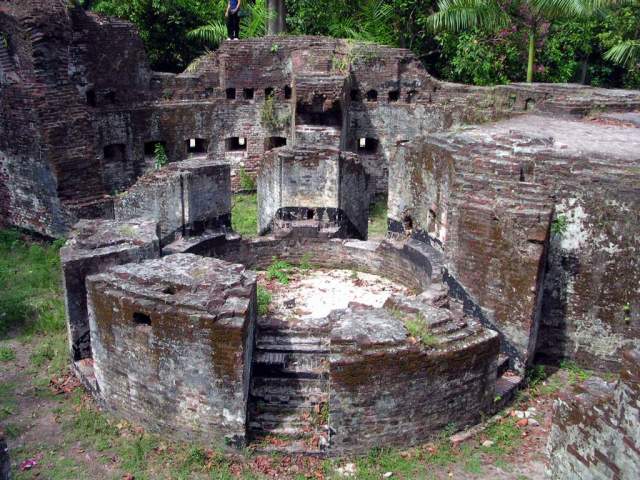 Menara Martello Tower Manggalani’s public tag photo Flickr.
Menara Martello Tower Manggalani’s public tag photo Flickr.
Early in the morning of May 20, 1883, the captain of the German warship Elizabeth reported seeing an ~11-km-high cloud of ash and dust rising above the uninhabited island of Krakatau, thus documenting the first eruption from this Indonesian island in at least two centuries. Over the ensuing two months, crews on commercial vessels and sightseers on charted ships would experience similar spectacles, all of which were associated with explosive noises and churning clouds of black to incandescent ash and pumice. From a distance, the largest of these natural fanfares impressed the local inhabitants on the coastal plains of Java and Sumatra, creating a near-festive environment. Little did they realize, however, that these awe-inspiring displays were only a prelude to one of the largest eruptions in historic times. A series of cataclysmic explosions began at mid-day on August 26, and ended on August 27 with a stupendous paroxysmal eruption. On this day, the northern two-thirds of the island collapsed beneath the sea, generating a series of devasting pyroclastic flows and immense tsunamis that ravaged adjacent coastlines. The events that began on August 26 would mark the last 24 hours on earth for over 36,000 people, and the destruction of hundreds of coastal villages and towns. (Source).
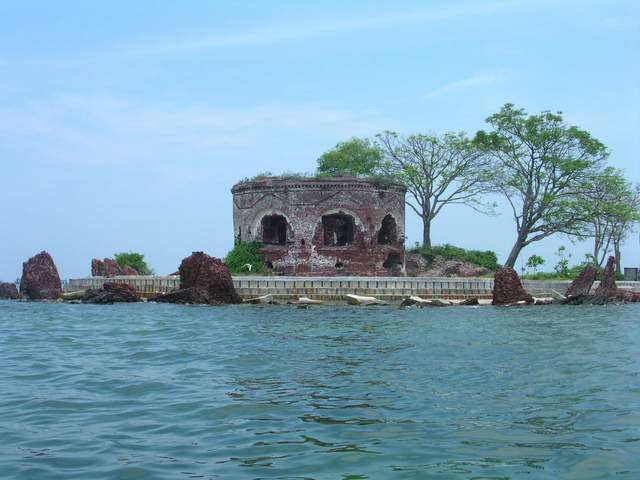 Palau Kelor islet beside Menara Tower. Photo courtesy Manggalani public tagged Flickr.
Palau Kelor islet beside Menara Tower. Photo courtesy Manggalani public tagged Flickr.
to be continued …….. _ _. _.._

